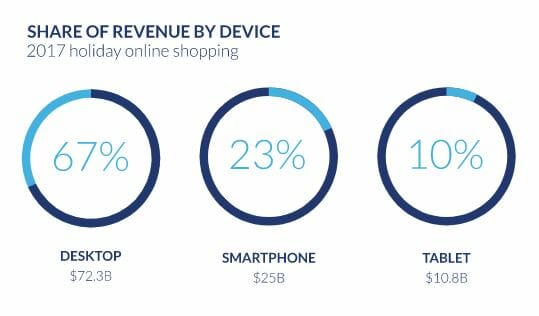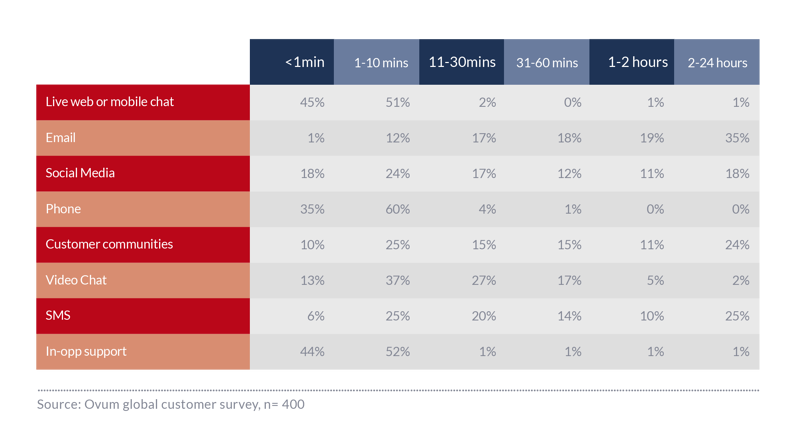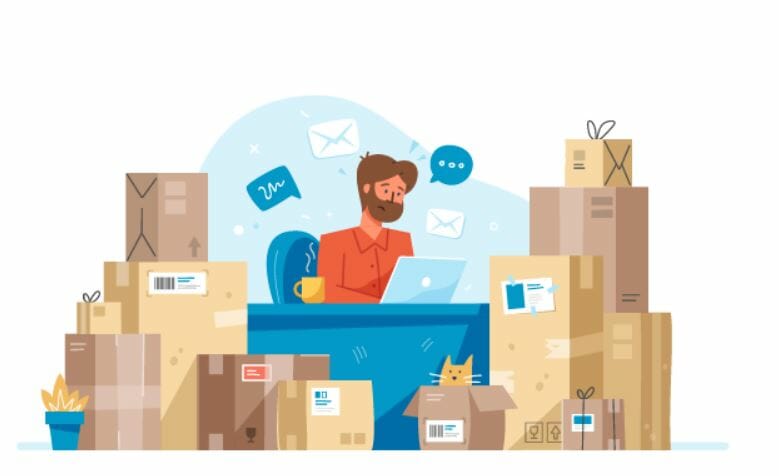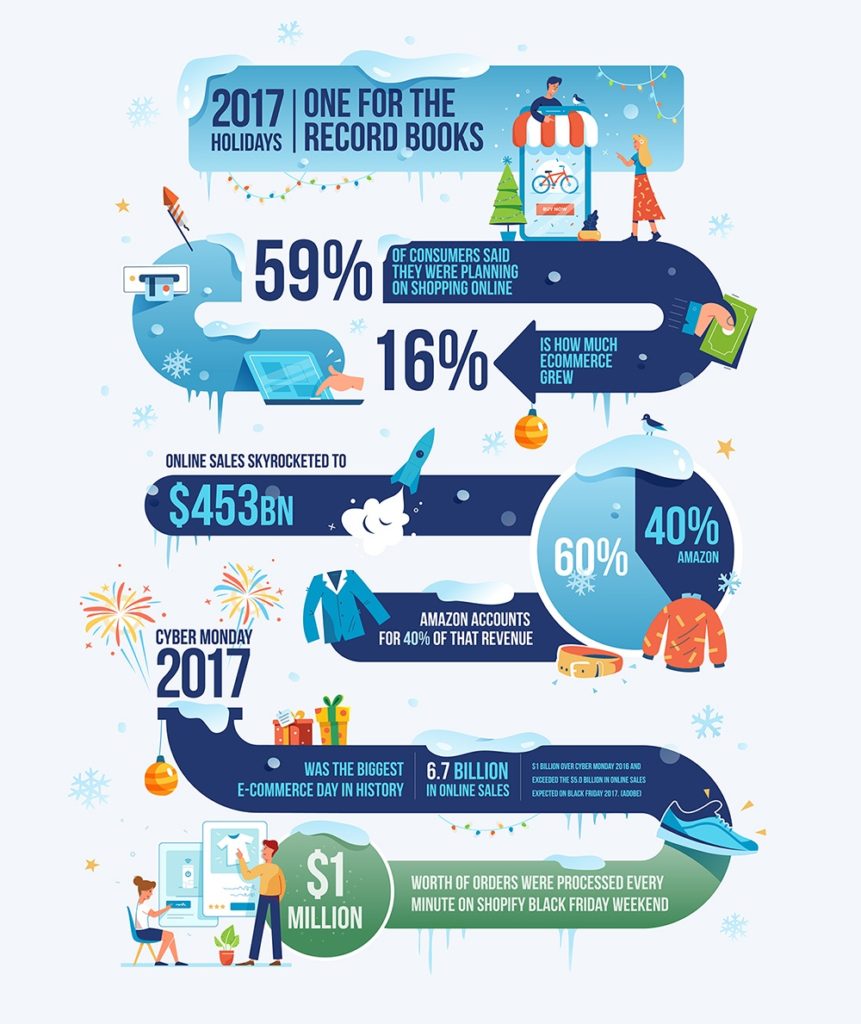The E-Commerce Entrepreneur’s Guide to Crushing the 2018 Holidays
Remember when it was summer?
Neither do we. This year, the “holiday season” is starting earlier than ever, with the big retailers scrambling for seasonal workers way back in June and the e-commerce world humming with a brand new buzzword: Black November.
Let’s rewind for a second. 2017 was the biggest year for online sales in recorded history. Cyber Monday generated $6.7 Billion in online sales, a $1 Billion jump from 2016. $1 Million worth of orders were processed ever minute on Shopify during Black Friday. Sweating yet? Don’t worry – we’re here to help! Our guide is here to help both seasoned and rookie e-commerce merchants navigate (and profit from) the holiday season.
Let’s get started
1. Holiday planning checklist – are you ready?
2. Customer service can make or break your holiday numbers
3. Fulfillment 101
4. How to create a value-add marketing plan
5. Protect your store from disaster
6. [Infographic] 2017 holiday season… by the numbers
Planning

The key to holiday success is good planning. Keep the following in mind for a successful holiday season.
People are browsing on mobile, but purchasing on desktop.
Now more than ever, customers are using multiple devices to make their online purchases. However, mobile accounts for just 38% of revenue, despite accounting for 59% of all browsing sessions. To put it simply: Consumers are browsing on their phones, but actually making the purchase on their desktops.
Why? According to eMarketer customers just generally prefer to use a PC for purchases; and have expressed concerns about the security and usability of their mobile devices.
Remember:
- Your payment page should be as easy on mobile as it is on desktop
- There needs to be a seamless cart transition from mobile to desktop

Abandoned carts are an ongoing problem.
Last year, over $4.5 Trillion in e-commerce sales was lost to abandoned carts. According to Forbes, potential customers relinquish their carts because:
- They were just browsing
- They were comparison shopping
- Shipping issues arose
- There was a lack of payment options
- They experienced technical issues with the shop’s website
It’s tough to make a dent in $4 Trillion, but there are steps you can take to mitigate the number of abandoned carts on your site. First two that come to mind are a great customer service strategy and expanded shipping options (we’ll get into those in a bit).
Make sure people can find you.
In not-so-shocking news: Google delivers 69% of website traffic and 67% of website revenue. If you’re not on top of your Google game, don’t worry. There’s still time to brush up.
Here are three quick ways to get started. (Remember: Now is the time to start on this, as it can take several months for SEO efforts to pay off.)
- Make your product pages as good as your actual product. Great product descriptions, photos, and reviews go a long way.
- Build backlinks by doing something (anything) to get media coverage.
- Put on your Mad Men hat and write some amazing ad copy for your meta tags.
- Hire a Pro
Get the full scoop here: 4 Quick Ways to Improve your Organic Search Results for Your E-commerce Store
Your site needs to be fast.
Google research shows that site speed matters more than any other website engagement metric. Not only does it create a better shopping (and purchasing) experience for your customers, speed is also a SEO ranking factor and decreases your bounce rate. Win-win-win.
Stock up!
One of the most common frustrations we’ve heard from e-commerce merchants is that they run out of inventory in the thick of the holidays. Luckily, with careful planning, it’s possible to avoid the heartbreak of empty shelves and empty-handed customers.
Cole South, co-founder of SDDC Goods (which owns and operates BirdRock Baby, Nextrino, and Gold BJJ), recalls that he was “drastically unprepared” during his first holiday season. His inventory quickly depleted and, in his words, “we had no clue what we were doing.”
Today, South wants fellow entrepreneurs to know that if you plan accordingly, the last two months of the year can account for 50% of your annual revenue – a figure he achieved on his second – and much more lucrative – go around with the holidays. His advice?
- Plan for success! Overorder your inventory for Q4. Spending more on inventory is less painful than running out in the middle of peak season.
- If you don’t hit your inventory targets, dial up the marketing.
Don’t underestimate January.
Just because the party’s over doesn’t mean your store will be quiet. In 2017, UPS estimated that 1.4 million packages would be returned to retailers on January 3, which the company labeled “National Returns Day.”
Need a refresher? Here’s our go-to resource on best practices for handling returns.
If you’re in the fitness, self-improvement, or health industries, your holiday season is far from over. Scores of customers brimming with high hopes for their New Year’s resolutions will be flocking to your site.
Understand the new sales tax laws.
On June 21, 2018 the Supreme Court ruled in favor of states requiring online retailers to collect sales taxes. The 5-to-4 decision had an immediate impact on American consumers, large online retailers, and, of course, small e-commerce businesses like yours.
Since the Wayfair ruling, if your e-commerce store passes a state’s economic threshold for total revenue or number of transactions in that state, you’re legally obligated to collect and remit sales tax to that state (even if you don’t have a physical presence in a state). Our friends at TaxJar take a deeper dive into Economic Nexus Laws– important stuff to know before the busiest time of the year for sales.
For Amazon sellers, we recommend getting your sales tax settings in order before Black Friday.
Customer Service

Why customer service is critical for e-commerce
It goes without saying that customer service is one of the most valuable tools in a small business’s arsenal. This is particularly true during the holidays, when customers come out in droves to browse, click, fret, vacillate, freak out about 2-day shipping and…hopefully… click “complete purchase” on your site. A solid customer service strategy will steer even the most erratic holiday shopper straight to your payment page. This is what we in the customer service biz like to call pre-sales support, and it’s an absolute must for the holidays.
A smaller e-commerce store with a proven record of stellar customer support can consistently compete with the major retailers. And during the holiday free-for-all, every competitive edge counts.
Customer service best practices
No matter your industry or customer base, the three basic tenets of good online customer service remain the same:
- Be fast.
- Be empathetic.
- Be everywhere.
Be fast.
Online shoppers want quick responses to their questions and concerns. On a normal day, 75% of consumers expect help within 5 minutes [McKinsey]. The timeframe is even less for live chat:

However, the stakes are higher over the holidays, as customers have more more items to buy, more questions to ask, and, unfortunately for your business, more places to shop.
Here are some of the best ways for a small e-commerce startup to elevate their customer service without crashing and burning:
Offer live chat.
Not only is live chat the #1 preferred channel for Millennials, it keeps your customers on your site longer (as opposed to redirecting to an FAQ page or contact form).
Provide 24/7 support.
Late night shoppers have questions, too. If they have to wait 24-48 hrs for a response, they’ll probably jump over to a competitor’s site.
If you’ve built a reputation of providing excellent customer service throughout the year, chances are high that you’ll be the first stop when it comes to holiday gifts for mom and dad.
Be empathetic.
Angry customers are an inevitable part of doing business. However, angry customers who are ignored or bulldozed by a company’s customer service team can be downright dangerous. They’ll leave bad reviews, which, for some startups that are just getting off the ground, can be absolutely devastating.
The best way to quell an irate customer is to listen to their concerns, empathize with their frustrations, and navigate a solution. Studies show that a customer who had a bad experience that was turned around by great customer service is more likely to return to that store than a customer who had a good experience.
Be everywhere.
Live chat, Twitter, Facebook Messenger, email, phone, SMS – the more channels on which you can reach your customers, the better. Plus, you’ll be able to figure out what your primary customer base prefers and build out from there. Here’s more on omnichannel customer service.
Is it ok to outsource customer service?
We defer to customer experience guru (and 20x J.D. Power award winner) Sue Nokes for this one. With 25+ years of experience successfully transforming Fortune 100 companies and motivating tens of thousands of customer service agents, Nokes’s passion for customer service runs deep.
Nokes says yes, it is ok to outsource customer service, but it’s not as simple as just handing over your customers to someone else. She recommends that business owners think about the following before making a decision to outsource:
- Identify the types of inquiries that your company receives.
- Find a company that will serve as a strategic partner, not just as an outsourcer.
- Outsource care of the customers who have quick, routine inquiries (80%) and keep the high-touch, high-complexity inquiries in-house (20%).
If you’re considering outsourcing customer service, it’s important to weigh the pros and cons.
Fulfillment

Boxes, shipping labels, bubble wrap, tracking, shipping: Fulfillment is the whole… package. Obviously, shipping is a major priority during the holidays, as companies compete for the fastest turnaround time for their customers.
According to National Retail Federaton consumer research, 68 percent of online shoppers expect free shipping even on purchases of less than $50. 47 percent say they typically back out if shipping isn’t free. And 38 percent expect two-day shipping to be free while 24 percent expect free same-day shipping.
“Retailers are literally racing to consumers’ doorsteps to meet rising expectations,” said Mark Matthews, NRF Vice President for Research Development and Industry Analysis.
When it comes to fulfillment for e-commerce companies, retailers have a couple options: Keep it in house or outsource the task to a 3rd party logistics (3PL) outsourcer.
Keeping fulfillment in-house makes sense for many e-commerce business, including those that personalize every item, as well as those that are small enough for self-fulfillment to still be manageable. However, as a business grows, they may need to turn to 3PL.
“The week before Christmas in 2005, our first holiday in business, a shipment with hundreds of items (huge for us at the time) was lost by the freight forwarding company in their BWI airport warehouse. We had to drive up there and sift through stacks and stacks of cardboard boxes and crates to find the needle(point) in the haystack. Found it and luckily we were able to deliver all the orders we had promised for Christmas. Probably would have disappointed enough people to severely damage the future of the biz”
Austin Branson, Co-Founder, Smathers and Branson
Pros and cons of outsourcing fulfillment during the holidays.
PROS
Frees up your time!
Fulfillment can be labor-intensive. Outsourcing gives entrepreneurs and their teams more time and flexibility to handle whatever Christmas chaos is catapulted their way.
Time = money
Outsourcing can save money if your full-time employees shift focus to growth and sales.
Saves space
Many companies share their offices with their inventory and packing supplies. While boxes are great for shipping, they make lousy officemates (and leave old food in the fridge).
CONS
It’s not always ideal for brand new businesses.
According to our friends at ShipBob, “unless you have a crowdfunding campaign with hundreds of backers lined up or know you will be receiving national attention for your product, you likely won’t need a 3PL right away. Similarly, if you don’t have inventory yet – whether it’s caught up in manufacturing or otherwise delayed – a 3PL won’t be able to help you right away without stock that’s ready to go.”
Thinking about outsourcing fulfillment? Read this.
Marketing

Move over, stockings and mistletoe, there’s a new holiday tradition in town: Suffocating consumers with so much online holiday marketing that their phones explode and their laptops dissolve into melted candy canes. And like most traditions, this one’s impossible to shake.
Online shopping is more accessible than ever; there are more online stores than ever; and the AI technology in ads is so good that you may actually see your face in an online ad for a Carnival Cruise.
Don’t let the onslaught of Big Box advertising deter your small business’s holiday ambitions. They may have multi-million dollar marketing budgets, but you’ve got flexibility, creativity, and a consumer base that wants to support small businesses on your side. You also have the following marketing tips from us.
“Our jobs get really easy when our clients have a story to tell, a message to share or a risk to take. This season, do things differently, cut through the noise. Launch a pop-up shop that brings your online store to the streets, offer exclusive, short-run products that Wow!, or take your fans on a holiday journey that only you could lead. You don’t have to be better, or spend more; you just have to be you.”
– Josh Thompson, Head of Digital Services, FutureShirts
Value-add marketing
Content is king, but valuable content is SuperKing. Long gone are the days of shoveling heaps of sales pitches and flashy ads in front of consumers. We’re immune to it, and it just doesn’t work.
As our friends at Smile.io have noted, 64 percent of customers describe ads as annoying or intrusive and over 615 million devices currently have an ad blocker installed. “Clearly customers are tired of traditional forms of marketing, and are looking for other ways to engage with the brands they shop with.”
This holiday season, invest in content-based, trust-building advertising that isn’t really advertising at all. Here are a few ways to do so:
- Tell a story – either in writing or in video – that strikes an emotional chord with consumers.
- If you know your target audience, give them information they can use – even if that information has nothing to do with your core business. For example, if your customers are fitness enthusiasts, write a series of healthy recipes that they can quickly download onto their phones (even though you sell running socks).
Marketing on social media
Facebook’s “Bringing People Closer Together” algorithm shift is the coal in a small business’s stocking. As you may recall (or perhaps you’ve blocked the memory), business pages experienced a drastic decrease in engagement, reach, video watch time, and referral traffic. Businesses of all sizes have been trying to navigate this new terrain and 2018 will be the first holiday season with restricted access to followers.
So, until Facebook launches a “Bringing People’s Money Closer to E-Commerce Sites” campaign, we gotta get creative. 13 Ways To Boost Facebook Content Engagement Post-Algorithm Shift.
You don’t have to offer discounts on your products
Offering an eye-popping discount on Black Friday sounds like a great way to market your product and attract new customers. But Charles Gaudet, CEO of Predictable Profits, has some tried-and-true advice for smaller e-commerce retailers: Don’t do it.
Yes, all the Big Box stores drastically slash prices throughout Q4. But the Big Box stores are operating on a completely different playing field. As Gaudet points out, the reason big retailers discount their products is because they’re selling undifferentiated goods. They’re competing with fellow behemoths and are trying to drive as much traffic as possible into their stores.
It’s much more valuable for smaller retailers to increase the perceived value of their products. How? Here are some suggestions:
- “Buy one get one” deals
- Bundling products/services into one package.
- Offering a payment plan. If you have premium services, a 0% interest rate is an enticing offer.
“There’s never been a company throughout history that has lasted over the long term doing nothing but competing on price.” –
– Charles Gaudet, CEO, Predictable Profits
Conversion marketing
The marketing shouldn’t stop once a potential customer lands on your site. Ross Beyeler from Growth Spark encourages e-commerce merchants to optimize their stores through onsite promotion. This can include:
- Holiday-specific product bundles
- Seamless onsite upsell
- Optional add-ons with a customer’s shopping cart
- Special promotions delivered via live chat
- Wish lists
- Side-by-side product comparisons
- Option to offer financing through a platform such as Bread or Sezzle.
Fraud Protection

Fun fact: In moments of panic, that “stomach dropping” feeling is actually the sensation of blood moving from your stomach to your extremities so you have more juice to run away (or stay and fight).
Many retailers know the feeling all too well. Like when Sweetlegs’s site crashed the day before Black Friday. Or when Target suffered a multi-million dollar data breach. Or when Les Sharma, owner of SnuggleFeet, had all of her products deleted by an inventory management app just a few weeks before Christmas.
Luckily for Sharma, she had her store data backed up. Which leads us to our next point:
Back up your e-commerce store!
Any downtime of your store during Q4 – even just for a day – could result in thousands of dollars in lost revenue. You might have already experienced this yourself, but once a product or page is deleted from your Shopify store, it’s gone forever. (Cue blood rushing to legs.)
So, during November and December, would you rather be crushing sales or manually rebuilding your store from scratch after an accidental deletion? Our friends at Rewind.io want to make sure it’s more of the former and none of the latter.
The easiest way to backup your e-commerce store is to set up daily, automatic backups using the Rewind app. Here’s how to backup Shopify or backup BigCommerce.
Make it easy for customers, but hard for fraudsters
Tightening up your store’s fraud standards in the middle of Q4 is a bad idea. The tendency, given the pressure of the season, is to turn conservative, to not blow it. The thinking goes: When in doubt, decline the order. Which is a good way to lose a customer for life.
In fact, Business Insider reported that in 2016 retailers would lose $8.6 billion to false declines, $2 billion more than the $6.5 billion in fraud they’d prevent.
Fraud protection is tricky business, which is why we’ve enlisted the help of Signifyd’s Mike Cassidy to help entrepreneurs navigate the best way to protect their sites without compromising customer experience. Click here for more.
Beware of Credit Card Chargebacks
Chargebacks were originally created by credit card companies to help protect their customers and their money. While it is an important safety feature in guarding against fraudulent charges, many merchants argue that some consumers may be taking advantage of the chargeback system.
“Shopify Scripts has been super helpful during Black Friday. The platform gives us the ability to utilize automated workflows. We can now screen for fraud and implement fraud filters automatically, instead of manually processing and validating things like billing and shipping addresses.”
– Peter Coughlin, Co-owner, EVO Gimbals
Infographics
Last year’s holiday season was a doozy. Not only did Amazon have its biggest holiday to date, but Cyber Monday 2017 was declared the biggest e-commerce day in history… registering a record $6.59 billion in sales.

As you prepare your company’s holiday roadmap, keep the following top of mind:
There are no signs of online sales slowing down this year. There are already 10 million more Amazon Prime members than in 2017 and many more smaller e-commerce stores up and running. Yes, Amazon accounted for about 40% of last year’s holiday e-commerce sales, but that means a big chunk of the pie is still up for grabs.
Better yet, research conducted by The Grommet and presented at IRCE shows that consumers are itching to support small businesses and often feel guilty about where they shop.

Resources We Love
Shopify Blog and ecommerce university
Shopify podcast
Kurt Elster’s unofficial Shopify podcast